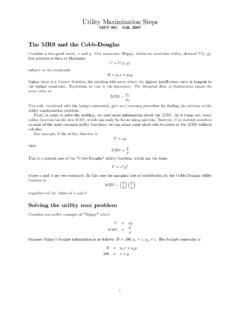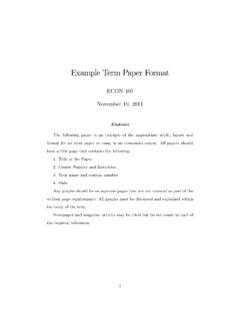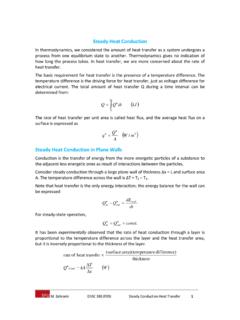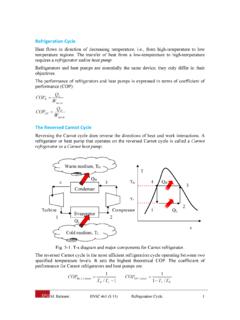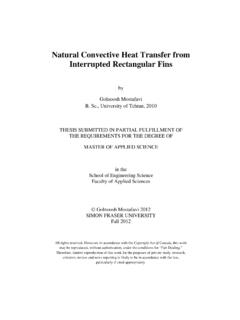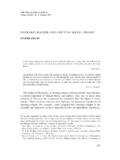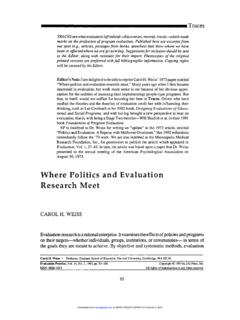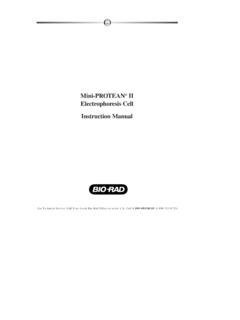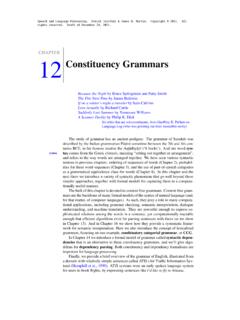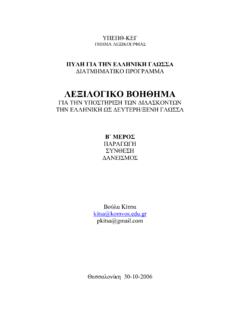Transcription of Thematic Roles - SFU
1 Thematic Roles Saeed: Chapter LING 222: Thematic Roles 1. List of Basic Thematic Roles AGENT: the initiator of some action, capable of acting with volition. Jack ate the beans. PATIENT: the entity undergoing the effect of some action, often undergoing some change of state. Sue mowed the lawn. THEME: the entity which is moved by an action, or whose location is described. Fred threw the rock. EXPERIENCER: the entity which is aware of the action or state described by the predicate but which is not in control of the action or state. Kim saw the deer. LING 222: Thematic Roles 2. 1. BENEFICIARY: the entity for whose benefit the action was performed. Mary studied hard for her mother.
2 INSTRUMENT: the means by which an action is performed or something comes about. Fred opened the lock with a paper clip. LOCATION: the place in which something is situated or takes place. The picture hangs above the fireplace. GOAL: the entity towards which something moves, either literally or metaphorically. Lee walked to school. SOURCE: the entity from which something moves, either literally or metaphorically. Sue ran from the policeman. LING 222: Thematic Roles 3. Additional Thematic Roles ACTOR: the entity which performs, effects, instigates, or controls the situation denoted by the predicate (supertype of AGENT): The bus hit a pedestrian. RECIPIENT: a subtype of GOAL involved in actions describing changes of possession.
3 Bill sold the car to Mary PERCEPT/STIMULUS: the entity which is perceived or experienced. Mary fears thunder. LING 222: Thematic Roles 4. 2. Tests for Thematic Roles Fred mowed the lawn. ACTOR. What X did was . What Fred did was mow the lawn. PATIENT. What happened to Y was . What happened to the lawn was that Fred mowed it. What X did to Y was . What Fred did to the lawn was mow it. LING 222: Thematic Roles 5. How many Thematic Roles can an NP have? Chomsky's 1981 Theta Criterion There must be a one-to-one correspondence between noun phrases and Thematic Roles . Jackendoff 1990: two-tier approach Sue hit Fred. Theme Goal ( Thematic tier). Actor Patient (action tier).
4 Pete threw the ball. Source Theme ( Thematic tier). Actor Patient (action tier). Bill entered the room. Theme Goal ( Thematic tier). Actor (action tier). Bill received a letter. Goal Theme ( Thematic teir). (action tier). LING 222: Thematic Roles 6. 3. Thematic Roles and Grammatical Relations Particular verbs allow certain mappings between grammatical relations and Thematic Roles : Jack broke the ice with a hammer. Gina raised the car with a jack. A hammer broke the ice. A jack raised the car. The ice broke. The car rose. Possible Universal Subject Hierarchy: AGENT > RECIPIENT/BENEFICIARY > THEME/PATIENT >. INSTRUMENT > LOCATION. A language that allows a subject at a particular spot on the hierarchy, also allows a subject anywhere to the left on the hierarchy.
5 English: This table seats eight , etc. LING 222: Thematic Roles 7. Thematic -Role Grid ( -grid). lexicon specifies Thematic Roles associated with arguments of a verb (subjects [external argument] &. complements, not adjuncts): put V: <AGENT, THEME, LOCATION>. FredAGENT put the glassTHEME on the tableLOCATION. Verb subclasses share the same -grid: TRANSFER VERBS: V: <AGENT, THEME, RECIPIENT>. give, lend, supply, pay, donate, contribute V: <RECIPIENT, THEME, SOURCE>. receive, accept, borrow, buy, purchase, rent, hire LING 222: Thematic Roles 8. 4. Problems with Thematic Roles Variation within Thematic Roles : John touched the lamp with his toe. The captain rubbed the cricket ball with dirt.
6 Henry squeezed the rubber duck in his hands. Alison smashed the ice cube with her heel. What semantic basis do we have for characterizing Thematic Roles ? LING 222: Thematic Roles 9. Dowty's 1991 Solution Thematic Roles are not semantic primitives, but are defined in terms of entailments. A sentence A entails a sentence B if any time A is true, B is also true: A: This is a red pen. B: This is a pen. AGENT Entailments: x murders y, x nominates y, x interrogates y x does some volitional act. x intends this to be the kind of act named by the verb. x causes some event to take place involving y. x moves or changes externally. LING 222: Thematic Roles 10.
7 5. Thematic Roles should be viewed as prototypes, where there may be different degrees of membership: Properties of the Agent Proto-Role a. volitional involvement in the event or state. b. sentience (and/or perception). c. causing an event or change of state in another participant. d. movement (relative to the position of another participant). Properties of the Patient Proto-Role a. undergoes change of state. b. incremental theme ( theme changes incrementally as action incrementally proceeds: mow the lawn). c. causally affected by another participant. d. stationary relative to movement of another participant. LING 222: Thematic Roles 11. Maggie pruned the roses.
8 Volitionality, sentience, causation, movement Prototypical Agent Joan felt the heat as the aircraft door opened. Sentience, causation, movement Less prototypical Agent: Experiencer The scalpel cut through the muscle. Causation, movement Still less prototypical Agent: Instrument Maggie pruned the roses. Change of state, incremental theme, causal affectedness, stationary Prototypical Patient Roberto watched the game. Incremental theme Less prototypical Patient: Percept LING 222: Thematic Roles 12. 6. Predicting Links between Grammatical Relations and Thematic Roles (Dowty). Argument Selection Principle: In predicates with grammatical subject and object, the argument for which the predicate entails the greatest number of Proto-Agent properties will be lexicalized as the subject of the predicate; the argument having the greatest number of Proto-Patient entailments will be lexicalized as the direct object.
9 Corollary 1: If two arguments of a relation have (approximately). equal numbers of entailed Proto-Agent and Proto-Patient properties, then either or both may be lexicalized as the subject (and similarly for the object). Corollary 2: With a three-place predicate, the non subject argument having the greater number of entailed Proto-Patient properties will be lexicalized as the direct object and the non- subject argument having fewer entailed Proto-Patient properties will be lexicalized as an oblique or prepositional object . LING 222: Thematic Roles 13. Example 1: Captain Nemo sank the ship with a torpedo. volitionality, sentience, causation, movement The torpedo sank the ship.
10 Causation, movement The ship sank. movement Example 2: John fears thunder. sentience Thunder scares John. causation LING 222: Thematic Roles 14. 7. Identifying Verbal Subclasses Psychological verbs type 1: V: <EXPERIENCER, STIMULUS>. admire, enjoy, fear, like, love, relish, savour Psychological verbs type 2: V: <STIMULUS, EXPERIENCER>. amuse, entertain, frighten, scare, interest, please, surprise, thrill LING 222: Thematic Roles 15. Describing Argument-Changing Alternations (Levin 1993). He banged the broom-handle on the ceiling. He banged the ceiling with the broom-handle. She tapped the can against the window. She tapped the window with the can.
